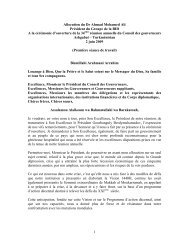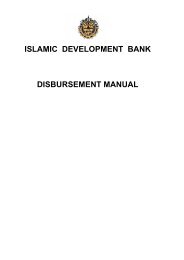Mauritania - Islamic Development Bank
Mauritania - Islamic Development Bank
Mauritania - Islamic Development Bank
You also want an ePaper? Increase the reach of your titles
YUMPU automatically turns print PDFs into web optimized ePapers that Google loves.
8<br />
TABLE 5: Exports Composition (% of Total Exports)<br />
2009 1996 2009 1996 2009 1996<br />
Iron Ore 57.9 59.83 68.58 35.88 41.27 34<br />
Gold na na na 0.13 2.80 16<br />
Copper na na na 0.44 12.58 14<br />
Oil na na na 50.05 25.02 10<br />
Fisheries<br />
products<br />
41.92 39.87 31.41 13.5 18.31 26*<br />
* For 2011 estimates the number for fisheries includes earnings<br />
from licenses.<br />
Source: CMAP 2010.<br />
observers –see table 4. Second, as noted above,<br />
<strong>Mauritania</strong> has simply been extracting these<br />
resources without adding much value thus<br />
limiting the size of its manufacturing sector and<br />
with it employment opportunities. Third, the<br />
dependence of the country on two main types<br />
of natural resources (iron ore and fisheries) has<br />
created vulnerability to external shocks. In 2010,<br />
the signs of recovery of the economy are mainly<br />
due to the performance of the iron ore sector.<br />
23. Poor performance of the agriculture and<br />
livestock production -- the main sources of<br />
livelihood for households in rural areas. The<br />
challenges faced by the <strong>Mauritania</strong>n farmers in<br />
making irrigated rice production profitable after<br />
more than a decade of efforts and investments<br />
reflects additional challenges. Farmers in rain-fed<br />
areas face the additional challenge from droughts<br />
and desertification, as noted above. The poor<br />
performance in agriculture over the past two<br />
decades, as already noted above, has occurred<br />
despite the large amounts of foreign aid directed<br />
to this sector. In 1994, 58% of foreign aids was<br />
allocated to rural and agriculture development<br />
(mainly for irrigation) 4 and some important<br />
projects were implemented including the<br />
Programme de Développement de l’Agriculture<br />
Irriguée en Mauritanie (PDIAIM) supported by the<br />
World <strong>Bank</strong>.<br />
24. Absence of an enabling environment for<br />
private sector development: The development<br />
of industries outside natural resource extraction<br />
faces several constraints in <strong>Mauritania</strong>. The small<br />
4 http://www.ifad.org/evaluation/public_html/eksyst/doc/country/pa/<br />
mauritania/cesmr98f_1.htm.<br />
size of the local market, poor infrastructure<br />
(roads, ports) and the high cost of water and<br />
electricity, shortages in skilled labor, weaknesses<br />
in the regulatory environment and lack of access<br />
to financing are among the main constraints to<br />
the development of <strong>Mauritania</strong>n industry. The<br />
poor enabling environment makes <strong>Mauritania</strong><br />
unattractive for investors including both foreign<br />
and local including SMEs. It is clear that oil and<br />
iron ore exploitation were the main beneficiaries<br />
of the increase of FDI flows in 2004-2005<br />
periods (see figure 8). This has exacerbated the<br />
unemployment situation as noted above. In<br />
addition to the weak demand for labor, the skills<br />
mismatch problem is also a critical constraint<br />
pointing to the need to improve skills and raise<br />
the low productivity.<br />
25. All the evidence indicates that <strong>Mauritania</strong><br />
has a unique dual economy structure:<br />
• A subsistence economy supporting more than<br />
two-thirds of the population and focused<br />
on crop production, livestock management<br />
and traditional coastal fisheries. Despite the<br />
massive exodus of the population from rural to<br />
urban areas mainly to Nouakchott (5% in 2008<br />
against 60% in 1960) 5 , following recurrent food<br />
crises (drought, locust invasions), two-thirds<br />
of the population still lives in and around the<br />
rain-fed agro-pastoral areas in the south.<br />
• A natural resource based modern “enclave”<br />
economy using capital-intensive production<br />
techniques to produce raw materials (iron ore,<br />
5 FAO et Programme Alimentaire Mondial, 2008, «Mission inter-agences de<br />
consultation avec le Gouvernement et les partenaires au développement».<br />
MCPS for <strong>Mauritania</strong>, 2011-2015






